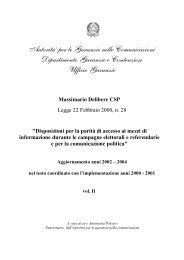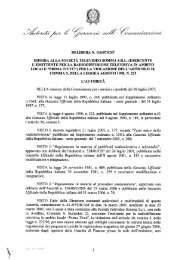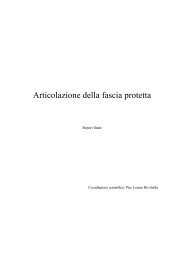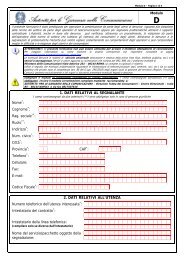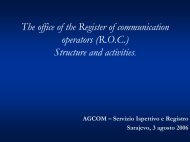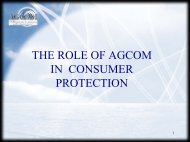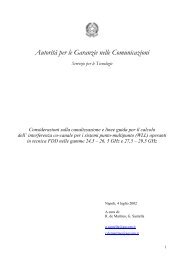Communications Regulatory Authority
Communications Regulatory Authority
Communications Regulatory Authority
Create successful ePaper yourself
Turn your PDF publications into a flip-book with our unique Google optimized e-Paper software.
In this connection it should be highlighted that the extension of the reserve<br />
obligation in favour of independent producers’ works to all broadcasters had<br />
specifically been requested by the European Commission for the purpose of<br />
bringing the Italian legislative framework in line with the “Television without<br />
frontiers” European directive. As a matter of fact, European regulations do not make<br />
the (all-Italian) distinction between holders of a licence issued in Italy by the<br />
Ministry of <strong>Communications</strong> (to broadcasters which use analog terrrestrial<br />
frequencies) and holders of an authorization, issued either by the same Ministry (to<br />
broadcasters broadcasting on cable or digital terrestrial frequencies) or by the<br />
<strong>Communications</strong> <strong>Regulatory</strong> <strong>Authority</strong> (to broadcasters which use satellite<br />
frequencies), and apply the same obligations to all national broadcasters.<br />
Compared to law no. 122/98, another innovation introduced by article 6 of the<br />
Consolidation Act is the adoption of the provision by which AGCOM laid down the<br />
instrument of derogation with regard to thematic channels, namely article 5 3 of the<br />
regulations passed with Resolution no. 9 of 16 March 2006. The reference made by<br />
article 6 of the Consolidation Act to article 5 of said regulations dispels all doubts as<br />
to said resolution still being in force.<br />
As far as AGCOM’s supervisory and monitoring action is concerned with regard<br />
to compliance with programming obligations it should be highlighted that, in<br />
compliance with the provision under articles 4 and 5 of the “Television without<br />
frontiers” Directive, AGCOM submitted to the European Commission its scheduled<br />
biennial report and attached tables showing percentages of European works,<br />
independent producers’ work and recent works broadcasted by Italian broadcasters<br />
in the years 2003 and 2004.<br />
The following tables are also on display together with the report published on<br />
the European Commission web site. It should also be pointed out that, as data<br />
included in the tables mainly derive from the IES, the “Informativa Economica di<br />
Sistema” (the Media and <strong>Communications</strong> Industry Database), those relating to<br />
compliance with 2005 programming obligations will be available as soon as<br />
broadcasters submit their IES for the year 2006.<br />
For data to be correctly understood it should be pointed out that, as the<br />
Consolidation Act was adopted in Italy in July 2005, in the 2003-2004 two-year<br />
period non-licensee broadcasters were still exempt from the obligation to schedule<br />
independent producers’ works, so that wherever a percentage was not available the<br />
relevant cell reads “Exempt”.<br />
Lastly, it should be pointed out that the Consolidation Act confirmed the original<br />
provisions set out in law no. 122/98, consequently requiring broadcasters and<br />
3 Article 5 of Resolution 9/99 states: “Each individual thematic channel can apply to AGCOM and duly<br />
set forth their reasons for a total or partial derogation to the investment and broadcasting reserve<br />
obligations as set out in these regulations”.<br />
177




